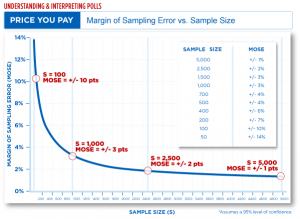Gary Segura recently provided a discussion of how exit polls often misrepresent Latino voters (Badly!), pointing out that exit polls often rely on small samples of Latino likely voters, rarely utilize fully bilingual interviews, and utilize samples that are not reflective of the Hispanic/Latino population in the location being polled. This is the first of a series of posts focused on whether the same problems plagued pre-election polls across states where Latino voters were critical to the election outcome. We start this discussion with a blog from Casey Klofstad, who has written several blogs for Latino Decisions focused on the state of Florida.
Identified as a “Latino Influence” state due to having a large and growing Latino electorate with an otherwise competitive electorate, Florida’s prized electoral voters hinged largely on how Latinos would vote in 2012. In the weeks immediately before the 2012 election, there was a great deal of speculation about whether the Latino vote would break for Obama. This speculation was fueled by polls suggesting that Obama’s share of the Latino vote was declining in Florida, and even in some cases, that Romney would get a greater number of Latino voters than Obama on Election Day.
For example, as I discussed in my last post for Latino Decisions, an Interactive Voice Response survey, or “robo-poll,” conducted on October 10-11 by Florida International University showed that 50.7% of Latinos in Florida who identified themselves as likely voters would vote for President Obama, with 44.2% supporting Governor Romney. With a margin of error of 3.65%, that put the race at dead even in Florida. These figures were not accurate for two reasons (hat-tip to Marc Caputo of the Miami Herald). One is that the FIU poll did not include cell phones. There is a growing consensus that omitting cell phones biases polling results in favor of the Republican Party. Conesquently, the Latino Decisions/ImpreMedia 2012 Election Eve Poll utilized both landline and cell phone-only households in our sample to account for this potential source of bias.
Another issue is that the figures were not corrected (i.e., “weighted”) to accurately account for the political attitudes of Cuban Americans, who are more Republican-leaning than other Latinos. This is akin to the fatal flaw of many exit polls identified by Gary Segura of polls not being reflective of the true Hispanic/Latino population in an area. Not only has the Latino population in the state of Florida grown substantially over time, but it has become more diverse, with Latinos of Puerto Rican and Dominican descent becoming a greater segment of the Latino electorate. Not accounting for this basic demographic shift can pose major problems for polls intended to predict election outcomes.
Another telephone poll conducted the week of October 8 by Mason-Dixon, showed Romney with 46% of the Latino vote compared to 44% for Obama. The poll included cell phones in the sample, which was an improvement upon the FIU poll. However, the poll was of 800 registered voters in Florida, 13% of whom were Latinos (N = 104). This sample size leads to a 10% margin of error for Latino respondents (see Figure below), making the 46-44 margin between Romney and Obama absolutely meaningless, not “ominous” as described in this article. This is another basic yet highly problematic source of bias that is often associated with exit polls as identified by Gary Segura’s post. In contrast to the Mason-Dixon poll, the Florida 2012 Election Eve Poll had over 800 interviews of Latino voters with a margin of error of +/- 3.5%.

The outcome of the 2012 election was drastically different from what these two flawed polls predicted. Exit polls in Florida show that Obama took 60% of the Latino vote in Florida, up from 57% in 2008. These results are commensurate with data collected by Latino decisions (see figure below), which showed Obama with an increasingly comfortable margin over Romney throughout the summer and fall. For example, the Election Eve Poll showed President Obama capturing a robust 58% of the Latino vote.

In the wake of these results, the media narrative has changed, citing the Latino vote as the reason Obama won Florida’s 29 electoral votes (though please read this to gain some perspective on whether the Cuban American vote has actually tilted towards the Democrats).
Casey A. Klofstad is an associate professor of political science at the University of Miami, Coral Gables, FL. He has a forthcoming article co-authored with Benjamin G. Bishin in Political Research Quarterly entitled, “The Political Incorporation of Cuban Americans: Why Won’t Little Havana Turn Blue?”. His book, Civic Talk: Peers Politics and the Future of Democracy, is now available in paperback. You can follow him on Twitter at @klofstad, and on Facebook at www.facebook.com/klofstad
The commentary of this article reflects the views of the author and do not necessarily reflect the views of Latino Decisions. Latino Decisions and Pacific Market Research, LLC make no representations about the accuracy of the content of the article.


